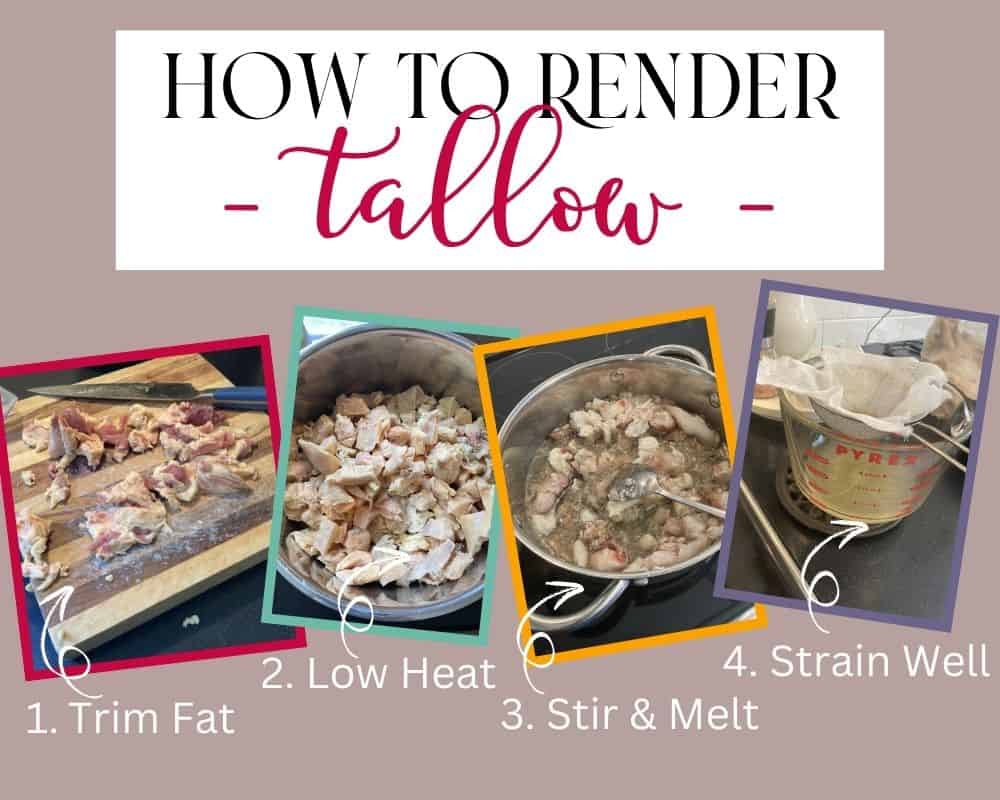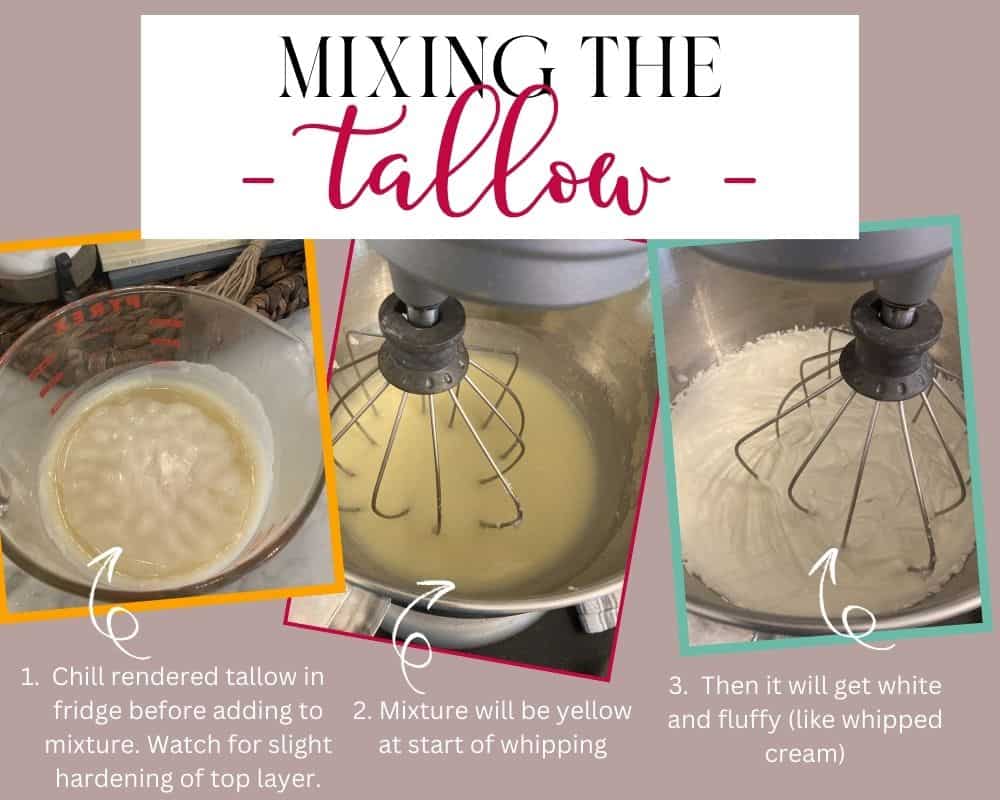Thinking about incorporating tallow face cream into your skincare routine? Let me show you how simple it is to make a DIY tallow balm that will knock your socks off! You can easily customize this recipe to include a few drops of your favorite essential oil.

You can download this recipe sheet and SO MUCH more in my Freebies Library!
(Affiliate links are included below. Please see my policies and disclaimers for more information.)
What is Tallow and Why Should I Use It?
Tallow is simply beef fat. Fat from any part of the cow is considered tallow, but some people prefer that fat that surrounds the organs (called suet). Tallow, especially from grass-fed cows rather than grain-fed cows, is packed with vitamins like Vitamin A, Vitamin D, Vitamin K, Vitamin E, and Vitamin B12 (source). Tallow is also an excellent source for a variety of fatty acids, which make amazing moisturizers. If you struggle with dry skin or struggle to keep your hands and feet moisturized during winter months, grass-fed tallow just might be the solution you’ve been looking for!
Tallow also offers tons of benefits for the skin. Marisa Garshick, MD, a New York dermatologists points out that the antioxidants found in tallow offer many benefits for the skin, such as increased collagen production and supporting general skin health (source). Tallow is also a great option for sensitive skin. According to Mariano Busso, MD, a board-certified dermatologist in Miami, is considered hypoallergenic, meaning it contains very few allergens that typically cause reactions (source).
Studies like this one show that people suffering from eczema, psoriasis, or other inflammatory skin conditions may benefit from the use of tallow. Grass-fed beef tallow contains conjugated linoleic acid, which has anti-inflammatory properties.
Benefits of Face Tallow Balm
- Uses natural products
- Inexpensive to make
- Boosts collagen production
- Contains fat-soluble vitamins for overall skin health
- May reduce the appearance of fine lines
- Hypoallergenic and good for many skin types (some even find it helps with acne-prone skin)
- Can use on entire body
- You’ll love how it makes your skin feel!
How to Render Tallow

This recipe calls for 1 cup of rendered tallow. So how do you render it? It’s quite simple, actually!
- Use a cutting board and knife to cut your animal fat into small chunks (approximately bite-size pieces). As you are cutting the tallow, cut away any visible pieces of meat that may be attached. I keep my tallow in the freezer until I’m ready to use it, so I just remove it 30 minutes or so before I’m ready to cut it up. I find that it is a little easier to cut if its still somewhat frozen.
- Add all of the tallow chunks to a small pan (some people choose to use a double boiler).
- Turn on very low heat.
- Stir often and keep a very close eye on the process. The tallow can overheat and burn quickly!
- Prepare for straining the tallow. You’ll need a large bowl or dish to collect the tallow (I use a large, 8-cup Pyrex measuring cup). You’ll also need a mesh strainer lined with cheese cloth. Place the strainer on top of the measuring cup.
- As you see the tallow melting, go ahead and pour off the liquid portion through the strainer. Return pan to heat, continue stirring and pouring off.
- When very little liquid fat is melting and the chunks begin to look shriveled up, you’ll know there is no more tallow to be rendered.
- Place the melted tallow in the fridge briefly before adding to your recipe. You’re looking for a very thin hard layer to form on top of the tallow. This formation should only take a few minutes.
Tallow Balm DIY Recipe
You truly won’t believe how easy it is to make your own natural skincare product! So let’s go!
(This article contains affiliate links. You can read more in my policies and disclaimers.)

Ingredients:
- 1 cup rendered, slightly cooled tallow
- 1/8 cup of avocado oil
- 1/8 cup olive oil
- 24 drops of lavender essential oil
- 24 drops of frankincense essential oil
(You could change out suggested oils for your favorite essential oils. Some people choose to use castor oil in place of avocado/olive oil, which is also a good option for skin.)
Directions:
- Combine all ingredients in a large mixing bowl.
- Add whisk attachment to your stand mixer. (You could also use a hand mixer.)
- Whip slowly at first, and gradually increase speed. Whip at full speed about 5 minutes. Mixture should be very smooth with a texture similar to whipped cream.
- Store in airtight container. Shelf life is about 2-3 months at room temperature or 6 months in fridge.
You may have to scrape sides of bowl multiple times to incorporate all of the tallow. If tallow hardens around edges of bowl, you can pop your entire mixing bowl into a 200 degree oven for a couple of minutes to soften it back up, then continue whipping.
I like to use disposable icing bags and piping tips to quickly pipe my tallow into small jars. I’ll leave one jar on bathroom counter for easy access, and I’ll store my extra jars in the fridge until I need them. The little yellow contraption pictured below makes it much easier to fill my piping bags, which can be a very messy job!

Final Thoughts on Grass Fed Tallow Balm
I’m pretty sure you/re going to fall in love with this tallow balm recipe like I have. In fact, many of my friends and family are now hooked on it too! If natural ingredients are important to you, you just can’t beat tallow cream. Coconut oil, shea butter and jojoba oil are all awesome, but they are plant based. In my experience, adding the tallow from a mammal is a game-changer. Which makes sense if you think about it…we are mammals, so of course tallow is more compatible with human skin!
Frequently Asked Questions
Where do you get your tallow?
My family buys half a grass-fed cow at a time from a local farmer. Since we are charged per pound of hanging weight, we are already paying for the fat whether we take it or not! So, I just ask the butcher to save my fat. I keep it in the freezer until I’m ready to use it.
If you don’t have access to local tallow, Amazon sells grass-fed tallow too!




